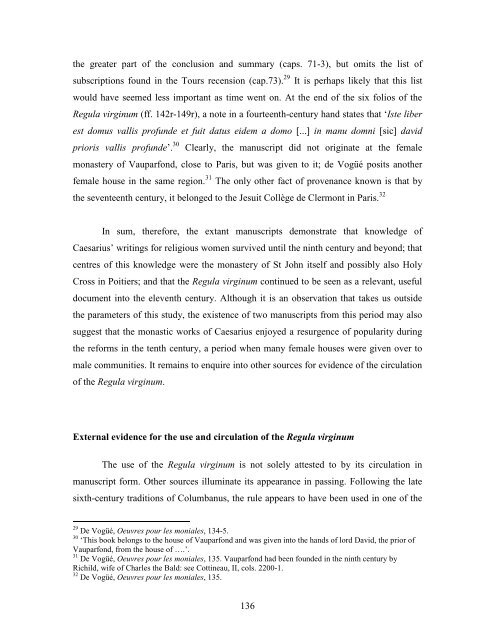Lindsay Rudge PhD Thesis - University of St Andrews
Lindsay Rudge PhD Thesis - University of St Andrews
Lindsay Rudge PhD Thesis - University of St Andrews
Create successful ePaper yourself
Turn your PDF publications into a flip-book with our unique Google optimized e-Paper software.
the greater part <strong>of</strong> the conclusion and summary (caps. 71-3), but omits the list <strong>of</strong><br />
subscriptions found in the Tours recension (cap.73). 29 It is perhaps likely that this list<br />
would have seemed less important as time went on. At the end <strong>of</strong> the six folios <strong>of</strong> the<br />
Regula virginum (ff. 142r-149r), a note in a fourteenth-century hand states that ‘Iste liber<br />
est domus vallis pr<strong>of</strong>unde et fuit datus eidem a domo [...] in manu domni [sic] david<br />
prioris vallis pr<strong>of</strong>unde’. 30 Clearly, the manuscript did not originate at the female<br />
monastery <strong>of</strong> Vauparfond, close to Paris, but was given to it; de Vogüé posits another<br />
female house in the same region. 31 The only other fact <strong>of</strong> provenance known is that by<br />
the seventeenth century, it belonged to the Jesuit Collège de Clermont in Paris. 32<br />
In sum, therefore, the extant manuscripts demonstrate that knowledge <strong>of</strong><br />
Caesarius’ writings for religious women survived until the ninth century and beyond; that<br />
centres <strong>of</strong> this knowledge were the monastery <strong>of</strong> <strong>St</strong> John itself and possibly also Holy<br />
Cross in Poitiers; and that the Regula virginum continued to be seen as a relevant, useful<br />
document into the eleventh century. Although it is an observation that takes us outside<br />
the parameters <strong>of</strong> this study, the existence <strong>of</strong> two manuscripts from this period may also<br />
suggest that the monastic works <strong>of</strong> Caesarius enjoyed a resurgence <strong>of</strong> popularity during<br />
the reforms in the tenth century, a period when many female houses were given over to<br />
male communities. It remains to enquire into other sources for evidence <strong>of</strong> the circulation<br />
<strong>of</strong> the Regula virginum.<br />
External evidence for the use and circulation <strong>of</strong> the Regula virginum<br />
The use <strong>of</strong> the Regula virginum is not solely attested to by its circulation in<br />
manuscript form. Other sources illuminate its appearance in passing. Following the late<br />
sixth-century traditions <strong>of</strong> Columbanus, the rule appears to have been used in one <strong>of</strong> the<br />
29<br />
De Vogüé, Oeuvres pour les moniales, 134-5.<br />
30<br />
‘This book belongs to the house <strong>of</strong> Vauparfond and was given into the hands <strong>of</strong> lord David, the prior <strong>of</strong><br />
Vauparfond, from the house <strong>of</strong> ….’.<br />
31<br />
De Vogüé, Oeuvres pour les moniales, 135. Vauparfond had been founded in the ninth century by<br />
Richild, wife <strong>of</strong> Charles the Bald: see Cottineau, II, cols. 2200-1.<br />
32<br />
De Vogüé, Oeuvres pour les moniales, 135.<br />
136

















